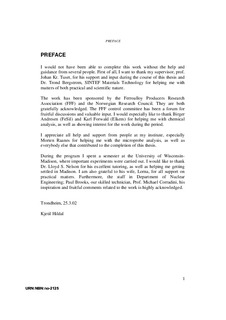| dc.description.abstract | Steam explosions are possible during granulation of Si and FeSi75. These explosions are a great hazard, and must be avoided. Norwegian ferroalloy producers have initiated a research program to learn more about such violent melt-water interactions, in a joint effort with NTNU and SINTEF. The focus has primarily been on important parameters that can be controlled industrially, such as water temperature and metal composition. This thesis-work has focused on the effect of small additions of Al and Ca in Si-metal and FeSi75. However, within the same project, experiments on the effect of water temperature have also been carried out.
The work has primarily been of experimental character. Two experimental apparatuses have been used. The first apparatus allows us to rapidly melt a sample of metal in an inert atmosphere to a desired temperature, expose the surface of the melt to an oxidizing agent (i.e. water) and then rapidly cool the sample to room temperature. The oxide that forms at the surface is examined with a microprobe. Thus, information regarding the composition and substance of the oxide layer is available. The second apparatus is suitable for releasing single drops of melt into a water tank, where they can be triggered and explode. A variety of techniques have been used in order to monitor the experiment: regular video, high-speed film, high-speed video, open-shutter imaging and pressure transducer measurements.
Both Si and FeSi75 must be triggered in order to explode. Trigger pressures range from 0.3 MPa (FeSi75) to 2 MPa (Si-metal). We have established at which depths the molten drops can be triggered. Molten drops of FeSi75 can be triggered at depths twice of those of molten drops of Si. The latter can be triggered even if they are partially solidified.
The explosion itself is strong enough to trigger neighbor drops as far away as 400 mm. Thus, we cannot rule out the possibility of large-scale steam explosions during granulation of molten Si or FeSi75, which is in accordance with industrial practice.
By the use of high-speed imaging techniques and pressure measurements, we have been able to describe qualitatively what happens when a molten drop of Si/FeSi75 fragments rapidly in water. As the melt fragments, the rapid heat transfer generates vapor as bubbles, which expand and collapse in a cyclic manner. Large pressure pulses are generated upon collapse of the steam bubble, that is, when water jets impact in the center of the collapsing bubble.
The first step in the oxidation of liquid silicon is the formation of gaseous SiO. The fate of this gas now depends on the flow conditions at the surface of the melt. In the case of a molten drop descending in water, most of the gas is flushed away from the surface. Thus, there are only minor traces of oxygencontaining material (i.e. silica) at the surface of the solidified drop.
The addition of small amounts of Al and/or Ca dramatically changes the behavior of the molten drop. A strange effect is the two-fold increase in the fall velocity for molten drops of silicon. A similar effect was detected for molten drops of FeSi75. Alloying elements such as Al and Ca greatly reduce the risk for a steam explosion of molten Si. The significance of these elements is related to the oxidation reactions at the surface of the molten drop of metal. As silicon reacts with water vapor and oxidizes, hydrogen gas is formed. If Al and Ca are present in the melt, these elements will speed up the hydrogen generation considerably. This gas is strongly influencing on the probability for a steam explosion to occur. H2 stabilizes the vapor film around the drop, that is, much stronger trigger pressures are needed to collapse the film. Even if the trigger pressure is strong enough to collapse the vapor film, violent interactions are almost completely absent. A fragmentation of the melt is observed, but the heat transfer is apparently not rapid enough to generate steam bubbles, i.e. the generation of steam is below the critical limit. | nb_NO |
